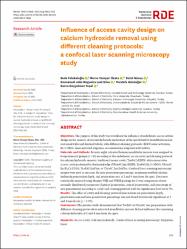| dc.contributor.author | Falakaloğlu, Seda | |
| dc.contributor.author | Yeniçeri Özata, Merve | |
| dc.contributor.author | Güneş, Betül | |
| dc.contributor.author | Gündoğar, Mustafa | |
| dc.contributor.author | Güçyetmez Topal, Burcu | |
| dc.contributor.author | Silva, Emmanuel João Nogueira Leal | |
| dc.date.accessioned | 2023-10-09T08:45:34Z | |
| dc.date.available | 2023-10-09T08:45:34Z | |
| dc.date.issued | 2023 | en_US |
| dc.identifier.citation | Falakaloğlu, S., Özata, M. Y., Güneş, B., Silva, E. J. N. L., Gündoğar, M., & Topal, B. G. (2023). Influence of access cavity design on calcium hydroxide removal using different cleaning protocols: a confocal laser scanning microscopy study. Restorative Dentistry & Endodontics, 48(3). | en_US |
| dc.identifier.issn | 2234-7666 | |
| dc.identifier.uri | https://dx.doi.org/10.5395/rde.2023.48.e25. | |
| dc.identifier.uri | https://hdl.handle.net/20.500.12933/1630 | |
| dc.description.abstract | Objectives: The purpose of this study was to evaluate the influence of endodontic access cavities design on the removal of calcium hydroxide medication of the apical third of mandibular incisor root canal walls and dentinal tubules with different cleaning protocols: EDDY sonic activation, Er,Cr:YSGG laser-activated irrigation, or conventional irrigation with IrriFlex.
Materials and methods: Seventy-eight extracted human mandibular incisors were assigned to 6 experimental groups (n = 13) according to the endodontic access cavity and cleaning protocol for calcium hydroxide removal: traditional access cavity (TradAC)/EDDY; ultraconservative access cavity performed in the incisal edge (UltraAC.Inc)/EDDY; TradAC/Er,Cr:YSGG; UltraAC.Inc/Er,Cr:YSGG; TradAC/IrriFlex; or UltraAC.Inc/IrriFlex. Confocal laser scanning microscopy images were used to measure the non-penetration percentage, maximum residual calcium hydroxide penetration depth, and penetration area at 2 and 4 mm from the apex. Data were statistically analyzed using Shapiro-Wilk and WRS2 package for 2-way comparison of non-normally distributed parameters (depth of penetration, area of penetration, and percentage of non-penetration) according to cavity and cleaning protocol with the significance level set at 5%.
Results: The effect of cavity and cleaning protocol interactions on penetration depth, penetration area and non-penetration percentage was not found statistically significant at 2 and 4 mm levels (p > 0.05).
Conclusions: The present study demonstrated that TradAC or UltraAC.Inc preparations with different cleaning protocols in extracted mandibular incisors did not influence the remaining calcium hydroxide at 2 and 4 mm from the apex. | en_US |
| dc.language.iso | eng | en_US |
| dc.publisher | Korean Academy of Conservative Dentistry | en_US |
| dc.relation.isversionof | 10.5395/rde.2023.48.e25. | en_US |
| dc.rights | info:eu-repo/semantics/openAccess | en_US |
| dc.subject | Access Cavity | en_US |
| dc.subject | Calcium Hydroxide | en_US |
| dc.subject | Confocal Laser Scanning Microscopy | en_US |
| dc.subject | Irrigation | en_US |
| dc.subject | Laser | en_US |
| dc.title | Influence of access cavity design on calcium hydroxide removal using different cleaning protocols: A confocal laser scanning microscopy study | en_US |
| dc.type | article | en_US |
| dc.authorid | 0000-0002-9932-9169 | en_US |
| dc.department | AFSÜ | en_US |
| dc.contributor.institutionauthor | Güçyetmez Topal, Burcu | |
| dc.identifier.volume | 48 | en_US |
| dc.identifier.issue | 3 | en_US |
| dc.relation.journal | Restorative dentistry & endodontics | en_US |
| dc.relation.publicationcategory | Makale - Uluslararası Hakemli Dergi - Kurum Öğretim Elemanı | en_US |
















